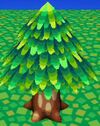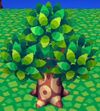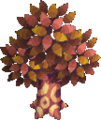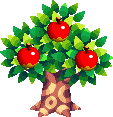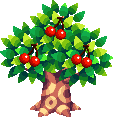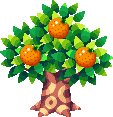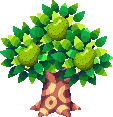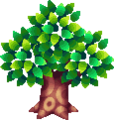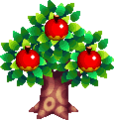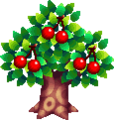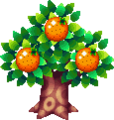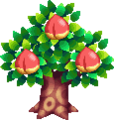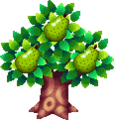Difference between revisions of "Tree"
m (Text replacement - "''New Leaf''" to "{{NL|short|nolink}}") |
m (→Palm tree) |
||
| Line 40: | Line 40: | ||
Palm trees bear [[Fruit|coconuts]] (or alternatively bananas in {{NL|short}}), which are special types of fruit; however, they only produce two instead of the usual three fruits. Some beetles, such as the [[Goliath Beetle]], will appear only on palm trees as well. In {{NL|short|nolink}}, palm trees can be found on [[Tortimer Island]], and in {{NH|short}} on the [[Mystery Island]]s. | Palm trees bear [[Fruit|coconuts]] (or alternatively bananas in {{NL|short}}), which are special types of fruit; however, they only produce two instead of the usual three fruits. Some beetles, such as the [[Goliath Beetle]], will appear only on palm trees as well. In {{NL|short|nolink}}, palm trees can be found on [[Tortimer Island]], and in {{NH|short}} on the [[Mystery Island]]s. | ||
| − | In {{WW|short}}, giving [[Wendell]] a coconut to eat will prompt him to give the player a unique [[design]]. | + | In {{WW|short}}, giving [[Wendell]] a coconut to eat will prompt him to give the player a unique [[design]]. |
| + | ==={{NL|short|nolink}}=== | ||
Palm trees can be grown by burying a coconut near the beach, on the grass within ten spaces of the shore. However, in {{NL|short|nolink}} and {{NH|short}}, palm trees are grown only in the sand. In {{PG}}, coconuts can be obtained from the [[island]], and in {{WW|short|nolink}} and {{CF|short}}, coconuts will wash up on the shore about once a week. In {{NL|short|nolink}}, coconuts and bananas can be obtained on Tortimer Island. | Palm trees can be grown by burying a coconut near the beach, on the grass within ten spaces of the shore. However, in {{NL|short|nolink}} and {{NH|short}}, palm trees are grown only in the sand. In {{PG}}, coconuts can be obtained from the [[island]], and in {{WW|short|nolink}} and {{CF|short}}, coconuts will wash up on the shore about once a week. In {{NL|short|nolink}}, coconuts and bananas can be obtained on Tortimer Island. | ||
Revision as of 10:16, June 24, 2020
| ||||||
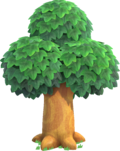 
Oak and Cedar trees in New Horizons | ||||||
| Type | Tree | |||||
|---|---|---|---|---|---|---|
| Appearances | Doubutsu no Mori, Animal Crossing, Doubutsu no Mori e+, Animal Crossing: Wild World, Animal Crossing: City Folk, Animal Crossing: New Leaf, Animal Crossing: New Horizons, 🎬 Gekijōban Doubutsu no Mori | |||||
| Main appearances | ||||||
|
| ||||||
| Other appearances | ||||||
Trees are common flora in the Animal Crossing series. Some trees bear fruit while others are just for decoration. Certain insects can be found in or on trees, depending on the season and time of day. The number of trees will affect the environment of a town and are used to determine perfect town status. With the exception of perfect fruit trees in Animal Crossing: New Leaf, fully grown trees do not die until they are chopped down by the player, leaving behind a stump. As of Animal Crossing: New Horizons, chopping trees also serves as a way to gather various crafting supplies.
Saplings
Saplings are baby trees available for purchase at Tom Nook's stores and the Garden Center. Not all trees grow successfully, due to poor soil quality and placement. If the player plants a tree where a different tree was cut down then it will have a much higher chance of growth. If the player stands on a tree sapling at exactly 6 a.m., the tree will grow around the player and knock them out, as though they had been bitten by a Tarantula or Scorpion.
Types of trees
Cedar tree
Cedar trees are evergreen trees. During December, particularly around Toy Day, and during the Bright Nights in Animal Crossing: Wild World, Cedar trees are decorated with bright lights. Cedar trees will only grow in the top two acres of the village, reflecting the fact that their real-life counterparts are found more frequently in the Northern Hemisphere, being adapted to colder temperatures.
Oak tree
Oak trees are generic trees, resembling fruit trees but bear nothing. Their appearance differs seasonally, turning golden brown in the autumn, being snow-laden in the winter, and bearing cherry blossoms during the Cherry Blossom Festival in April. In New Horizons, they will bear Leaf Eggs during the Bunny Day season.
Fruit tree
Fruit trees resemble Oak trees but bear fruit, three at a time. During the Acorn Festival they also bear acorns. There are 5 different varieties of fruit trees (13 in New Leaf), one for each type of fruit. The player can receive non-native fruits in letters from Mom, or from other villagers, after which they can then be grown into a fruit-bearing tree. Non-native fruit trees can also be found by going on a Mystery Island Tour.
Palm tree
Palm trees bear coconuts (or alternatively bananas in New Leaf), which are special types of fruit; however, they only produce two instead of the usual three fruits. Some beetles, such as the Goliath Beetle, will appear only on palm trees as well. In New Leaf, palm trees can be found on Tortimer Island, and in New Horizons on the Mystery Islands.
In Wild World, giving Wendell a coconut to eat will prompt him to give the player a unique design.
New Leaf
Palm trees can be grown by burying a coconut near the beach, on the grass within ten spaces of the shore. However, in New Leaf and New Horizons, palm trees are grown only in the sand. In Animal Crossing, coconuts can be obtained from the island, and in Wild World and City Folk, coconuts will wash up on the shore about once a week. In New Leaf, coconuts and bananas can be obtained on Tortimer Island.
Money tree
Money trees are a rare variety of tree that bears money as its fruit. They can be grown by burying bells in the ground with a golden shovel. In Animal Crossing and Animal Crossing: New Horizons, the player can grow a money tree by burying bells in the daily glowing spot instead. To maximize potential return and minimize expected loss, the ideal amount to bury is 30,000 bells.
Golden tree
Golden trees appear only in Animal Crossing, where golden shovels can be shaken from it. They are grown by planting a shovel in a glowing spot that appears once a day in the village.
Dead tree
These appear only in Animal Crossing: New Leaf. When a perfect fruit tree is shaken 4 to 7 times, it dies and becomes a dead tree, which serves no use to the player and should be cut down. When a perfect fruit tree dies, it produces a rotten fruit in addition to two perfect fruit. However, in Animal Crossing: New Leaf - Welcome amiibo, fertilizer can revive dead trees.
Bamboo tree
Bamboo tree debuted in Animal Crossing: New Leaf, where the bamboo shots could be purchased in the Garden Center. Fully grown bamboo stalks can spread on their own. In Animal Crossing: New Horizons, the bamboo trees are a source of crafting materials. During spring, they will produce young spring bamboo that is used in seasonal recipes. Bamboo shoots can be found on the Mystery Island Tour or received from Daisy Mae.
Shaking trees
While all trees may be shaken by the player, only cedar and non fruit-bearing trees have a chance of containing hidden items. Each day a certain amount of 100 bell bags, beehives, and furniture leaves will be scattered among the town's trees. This number varies according to the total number of trees in the town as well as the iteration of Animal Crossing being played. The table below lists the item maximums according to game title.
| Title | Bell Bags | Beehives | Furniture Leaves |
|---|---|---|---|
| Animal Crossing | 30 | 5 | 2 |
| Animal Crossing: Wild World | 16 | 4 | 2 |
| Animal Crossing: City Folk | 30 | 5 | 2 |
| Animal Crossing: New Leaf | 20 | 5 | 2 |
Shaking trees may give more than 100 bells, depending on the Player's Luck for that day.
Tree stumps
All games in the Animal Crossing series allow the player to chop down trees, producing a stump. These stumps do not count as trees (or weeds) when determining perfect town status. Animal Crossing: City Folk introduced two insect species only found on stumps (Violin Beetle and Longhorn Beetle), and Animal Crossing: New Leaf introduced the ability for players to use stumps as chairs, and special tree stump designs next to which mushrooms may appear.
Special stump designs
There are twelve stump designs in New Leaf. Six of these are exclusive to cedar trees, while the remainder are exclusive to fruit, bell and oak trees. Special stump designs are created by delivering the final blow to a tree with any axe. A silver axe guarantees a special design while a gold axe produces one only occasionally, while a regular axe hardly ever produces one. Because only the final blow (of three) is the one that determines whether the stump will feature a special design, the first two swings can be made using a regular or gold axe to reduce wear on a silver axe.
The oak, bell and fruit tree designs are, as follows; a heart design, a butterfly, a citrus pattern, a ginkgo leaf (the one that Crazy Redd uses as his logo), a cross (X) and a Triforce from The Legend of Zelda series. The cedar tree designs are a star, a cat, a flower similar to the one used to represent the Pikmin series, the leaf Tom Nook uses as a logo and the one furniture is turned into when in the players pockets, a music note and a four-leaf clover.
Gallery
Artwork
Animal Crossing
- Oak Tree GC.png
Oak Tree
- Cedar Tree GC.png
Cedar Tree
- Peach Tree AC.png
Peach Tree
Animal Island (GBA)
- IslandOakTree.png
Oak Tree
- IslandAppleTree.png
Apple Tree
- IslandCherryTree.png
Cherry Tree
- IslandOrangeTree.png
Orange Tree
- IslandPeachTree.png
Peach Tree
- IslandPearTree.png
Pear Tree
- IslandCoconutTree.png
Coconut Tree
- IslandGBAStump.png
Oak Tree Stump
- IslandCoconutStump.png
Coconut Tree Stump
Animal Crossing: Wild World
Animal Crossing: City Folk
- OakTreeCFArt.png
Oak Tree
- CFCedarTreeArt.png
Cedar Tree
- SeasonalCedarCF.png
Seasonal Cedar Tree
- Apple Tree.jpg
Apple Tree
- Cherry Tree.jpg
Cherry Tree
- Orange Tree.jpg
Orange Tree
- Peach Tree.jpg
Peach Tree
- Pear Tree.jpg
Pear Tree
Animal Crossing: New Leaf
- Tree NL.png
Oak Tree
Animal Crossing: New Horizons
- Oak Tree NH Autumn.png
Oak Tree - Autumn
Screenshots
- PalmTreesGCN.png
- Wild World interface.png
- ACCF Oak Trees Screenshot.jpg
- Cherry blossom trees.jpg
City Folk
- CityFolkPalmTree.jpg
City Folk
- FruitTreesCityFolk.jpg
City Folk
New Leaf (pre-release)
- Leafless tree.JPG
New Leaf
- Tree stump.JPG
New Leaf
References
| Flora | ||||||||||||||||
|---|---|---|---|---|---|---|---|---|---|---|---|---|---|---|---|---|
| ||||||||||||||||
| Geography | ||||||||||||
|---|---|---|---|---|---|---|---|---|---|---|---|---|
| ||||||||||||
